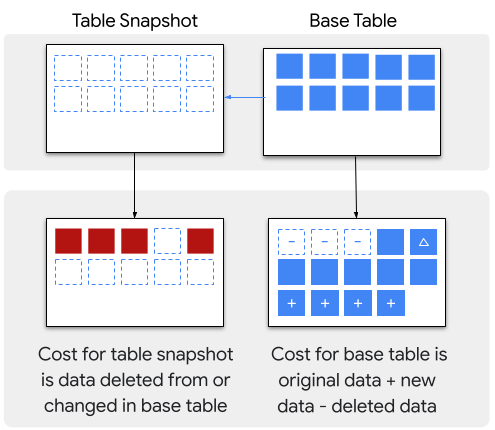表快照简介
本文档介绍 BigQuery 表快照。本文是介绍如何使用 BigQuery 表快照的一组文档中的第一篇,包括如何创建、恢复、更新、查询表快照以及获取有关表快照的信息。本文档集适合熟悉 BigQuery 和 BigQuery 表的用户。
表快照
BigQuery 表快照保留表(称为基表)在特定时刻的内容。您可以保存当前表的快照,也可以创建表在过去七天内任何时刻的快照。表快照可以具有到期时间;您可以配置一个时间段,从表快照创建开始计算的该时间段后,BigQuery 会删除表快照。您可以像查询标准表一样查询表快照。表快照是只读的,但您可以从表快照创建(恢复)标准表,然后可以修改恢复的表。
使用表快照的好处包括:
将记录保留七天以上。使用 BigQuery 时间旅行功能,您只能访问七天之前或更近几天的表数据。使用表快照,您可以根据需要从指定的时间点保留表数据。
最大程度地减少存储费用。BigQuery 仅存储快照与其基表之间不同的字节,因此表快照使用的存储空间通常少于表的完整副本。
如果您需要表的轻量级可变副本,请考虑使用表克隆。
表快照的访问权限控制
表快照的访问权限控制与表的访问权限控制类似。如需了解详情,请参阅使用 IAM 控制对资源的访问权限。
查询表快照
您可以采用与查询其他类型的 BigQuery 表相同的方式查询表快照的数据。如需了解详情,请参阅查询 BigQuery 数据。
存储费用
存储费用适用于表快照,但 BigQuery 仅对表快照中尚未计入另一个表的数据收费:
创建表快照时,表快照最初不产生任何存储费用。
如果在创建表快照后向基表添加了新数据,则您无需为在表快照中存储该数据付费。
如果在基表中更改或删除了同时也存在于表快照中的数据,则会产生以下费用:
您需要为已更改或已删除数据的表快照存储付费。
如果基表按物理存储计费,则时间旅行和故障安全费用不会计入基表。删除快照后,系统会向您收取时间旅行和故障安全费用。
如果有多个快照包含已更改或已删除的数据,则您只需为最早的快照使用的存储空间付费。
在同一区域内或者从一个区域或多区域复制表快照或克隆到另一个区域时,系统会创建表的完整副本。这会产生额外的存储费用。
下图显示了基表和表快照的存储费用之间的差异:

如需了解详情,请参阅 BigQuery 存储价格。
限制
表快照必须与其基表位于同一区域中并且在同一组织下。如果您选择其他区域中的数据集,BigQuery 会在该区域的目标数据集中创建相应表的副本。
表快照为只读状态;除非通过快照创建标准表然后更新数据,否则您无法更新表快照中的数据。您只能更新表快照的元数据,例如其说明、失效日期和访问权限政策。
由于时间旅行的限制为七天,因此您只能截取七天前或更近几天的表数据快照。
您无法截取视图或具体化视图的快照。
无法截取外部表的快照。
创建表快照时,无法覆盖现有表或表快照。
如果为包含写入优化存储空间(流式传输缓冲区)中的数据的表创建快照,则写入优化存储空间中的数据不会包含在表快照中。
如果为包含时间旅行中的数据的表创建快照,则时间旅行中的数据不会包含在表快照中。
如果为设置了分区过期时间的分区表创建快照,则分区过期时间信息不会保留在快照中。快照表改为使用目标数据集的默认分区到期时间。如需保留分区过期时间信息,请改为复制表。
配额和限制
如需了解适用于表快照的配额和限制,请参阅表快照配额和限制。
